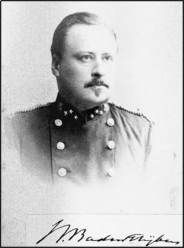- GHIJBEN
- NETHERLANDS (see also List of Individuals)\
 26.10.1845 Breda/NL - 13.11.1907 Arnhem/NL\Willem Badon Ghijben (Badon is part of the family name) joined the Dutch Army in 1862 and became a Member of the Army Corps of Engineers. He added to several defence structures and was an expert in the typical Dutch water fortress system in which artificial inundations formed an important defence strategy. His authoritative book on the extensive water and fortress defence line protected Holland until World War I, He also was a Lecturer at the Royal Military Academy. Because of poor health, Ghijben retired in the rank of a colonel in 1902.\Groundwater was extracted in Holland from dunes by a series of drainage canals from the 1850s because of shortage in drinking water in the larger cities. It was believed that the groundwater extension below the dunes was only some meters and that the subsurface consisted predominately of sand to at least a depth of 100 m such that the fresh water in the upper layers had removed the original salt water by hydrostatic pressure. The dune water was piped for instance to Amsterdam but in the event of war, the enemy could cut off the town from its water supply. Captain Badon Ghijben was commissioned to explore the Amsterdam subsurface and discovered a number of suitable freshwater pockets surrounded by salty water and advised drilling. He found that the interface between fresh and salt water under the dune area was around 42 times the elevation of the groundwater level above the sea level. His work received recognition only by the German Herzberg in 1901, who concluded that the freshwater extended in the area to a depth of some 60 m because of the density difference between fresh and salt water. Today, this anomaly is referred to the Ghijben-Herzberg principle. It was later extended by accounting for the dynamic effect of a fresh groundwater lens.\Badon Ghijben, W. (1877). De droogmaking der Zuiderzee: Open brief van de Maatschap tot droogmaking van het zuidelijk degeelte der Zuiderzee. van Bonga: Amsterdam.Badon Ghijben, W. (1881). De plannen tot droogmaking van de plassen beoosten de Vecht, in verband met de belangen van de defensie en den waterstaatkundigen toestand. Breda.Drabbe, J., Badon Ghijben, W. (1888). Nota in verband met de voorgenommen putboring nabij Amsterdam. Tijdschrift van het Koninklijk Instituut van Ingenieurs 5: 8-22.Vries, J.J. de (1994). Willem Badon Ghijben and Johan M.K. Pennink: Pioneers of coastal dune hydrology. Applied Hydrogeology 2(40): 55-57. PVries, J.J. de (2004). From speculation to science: The founding of groundwater hydrology in the Netherlands. Dutch pioneers of the earth sciences: 139-164, R.P.W. Visser, J.L.R. Touret, eds. Koninklijke Nederlandse Akademie van Wetenschappen: Amsterdam. P
26.10.1845 Breda/NL - 13.11.1907 Arnhem/NL\Willem Badon Ghijben (Badon is part of the family name) joined the Dutch Army in 1862 and became a Member of the Army Corps of Engineers. He added to several defence structures and was an expert in the typical Dutch water fortress system in which artificial inundations formed an important defence strategy. His authoritative book on the extensive water and fortress defence line protected Holland until World War I, He also was a Lecturer at the Royal Military Academy. Because of poor health, Ghijben retired in the rank of a colonel in 1902.\Groundwater was extracted in Holland from dunes by a series of drainage canals from the 1850s because of shortage in drinking water in the larger cities. It was believed that the groundwater extension below the dunes was only some meters and that the subsurface consisted predominately of sand to at least a depth of 100 m such that the fresh water in the upper layers had removed the original salt water by hydrostatic pressure. The dune water was piped for instance to Amsterdam but in the event of war, the enemy could cut off the town from its water supply. Captain Badon Ghijben was commissioned to explore the Amsterdam subsurface and discovered a number of suitable freshwater pockets surrounded by salty water and advised drilling. He found that the interface between fresh and salt water under the dune area was around 42 times the elevation of the groundwater level above the sea level. His work received recognition only by the German Herzberg in 1901, who concluded that the freshwater extended in the area to a depth of some 60 m because of the density difference between fresh and salt water. Today, this anomaly is referred to the Ghijben-Herzberg principle. It was later extended by accounting for the dynamic effect of a fresh groundwater lens.\Badon Ghijben, W. (1877). De droogmaking der Zuiderzee: Open brief van de Maatschap tot droogmaking van het zuidelijk degeelte der Zuiderzee. van Bonga: Amsterdam.Badon Ghijben, W. (1881). De plannen tot droogmaking van de plassen beoosten de Vecht, in verband met de belangen van de defensie en den waterstaatkundigen toestand. Breda.Drabbe, J., Badon Ghijben, W. (1888). Nota in verband met de voorgenommen putboring nabij Amsterdam. Tijdschrift van het Koninklijk Instituut van Ingenieurs 5: 8-22.Vries, J.J. de (1994). Willem Badon Ghijben and Johan M.K. Pennink: Pioneers of coastal dune hydrology. Applied Hydrogeology 2(40): 55-57. PVries, J.J. de (2004). From speculation to science: The founding of groundwater hydrology in the Netherlands. Dutch pioneers of the earth sciences: 139-164, R.P.W. Visser, J.L.R. Touret, eds. Koninklijke Nederlandse Akademie van Wetenschappen: Amsterdam. P
Hydraulicians in Europe 1800-2000 . 2013.
